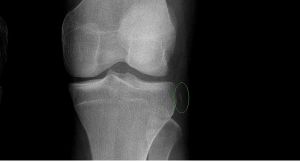We need you! Join our contributor community and become a WikEM editor through our open and transparent promotion process.
Segond fracture
From WikEM
Contents
Background
- Avulsion fracture of proximal lateral tibia
- Pathognomic for ACL tear
Clinical Features
ACL
- Hearing/feeling a "pop" during injury with ensuing knee instability is pathognomonic
- Anterior Drawer Sign
- Pt supine, knee flexed 90', attempt to displace tibia from femur in a forward direction
- Displacement of >6mm compared w/ opposite knee indicates injury
- Lachman Test (most sensitive)
- Pt supine, knee flexed 30', femur held w/ one hand, prox tibia pulled up w/ other hand
- Displacement >5mm or soft end-point indicates injury
- Pivot Shift Test
- Segond Fracture
- Pathognomonic for ACL tear but rare
Differential Diagnosis
Knee diagnoses
Acute Injury
- Knee fractures
- Patella fracture
- Tibial plateau fracture
- Knee dislocation
- Patella dislocation
- Segond fracture
- Meniscus and ligament knee injuries
- Patellar Tendinitis (Jumper's knee)
- Patellar tendon rupture
- Quadriceps tendon rupture
Nontraumatic/Subacute
- Septic Joint
- Gout
- Popliteal cyst (Baker's)
- Prepatellar bursitis (nonseptic)
- Septic bursitis
- Pes anserine bursitis
- Patellofemoral syndrome (Runner's Knee)
- Patellar Tendinitis (Jumper's knee)
- Osgood-Schlatter disease
- Arthritis
Evaluation
- Plain film
Management
- Knee immobilization
- Orthopedics follow up

